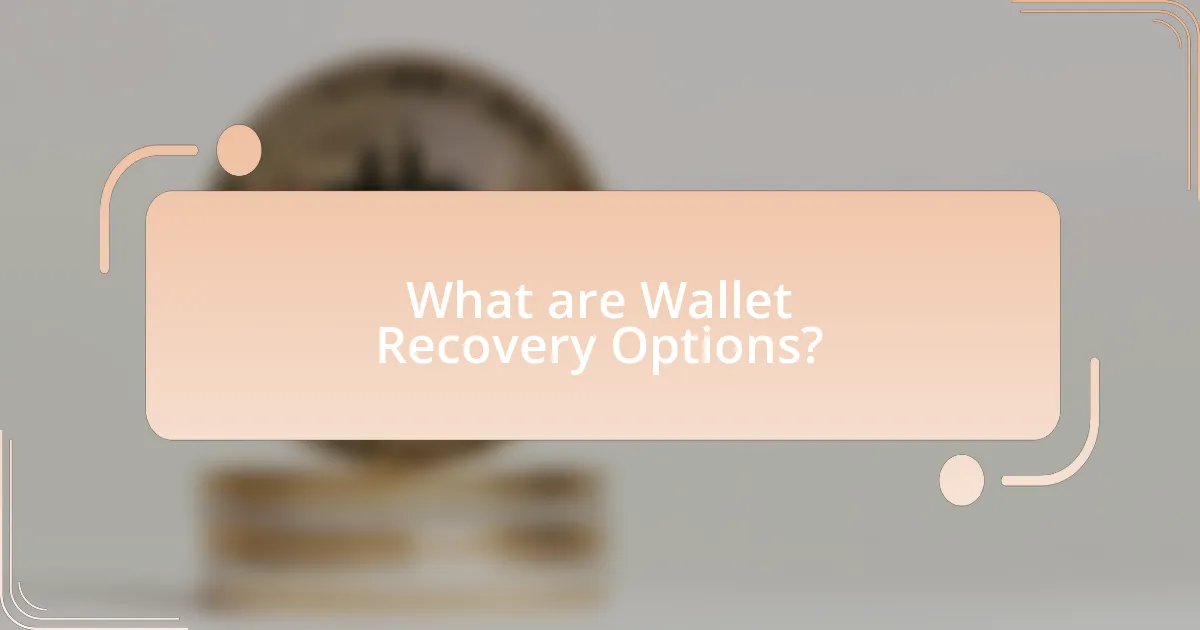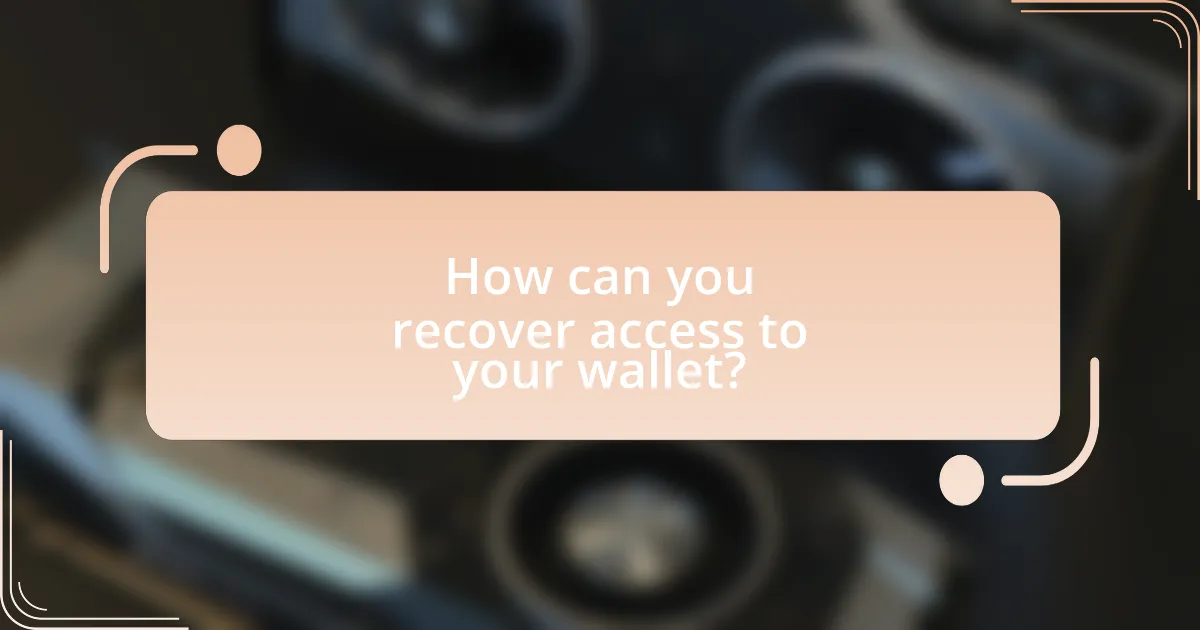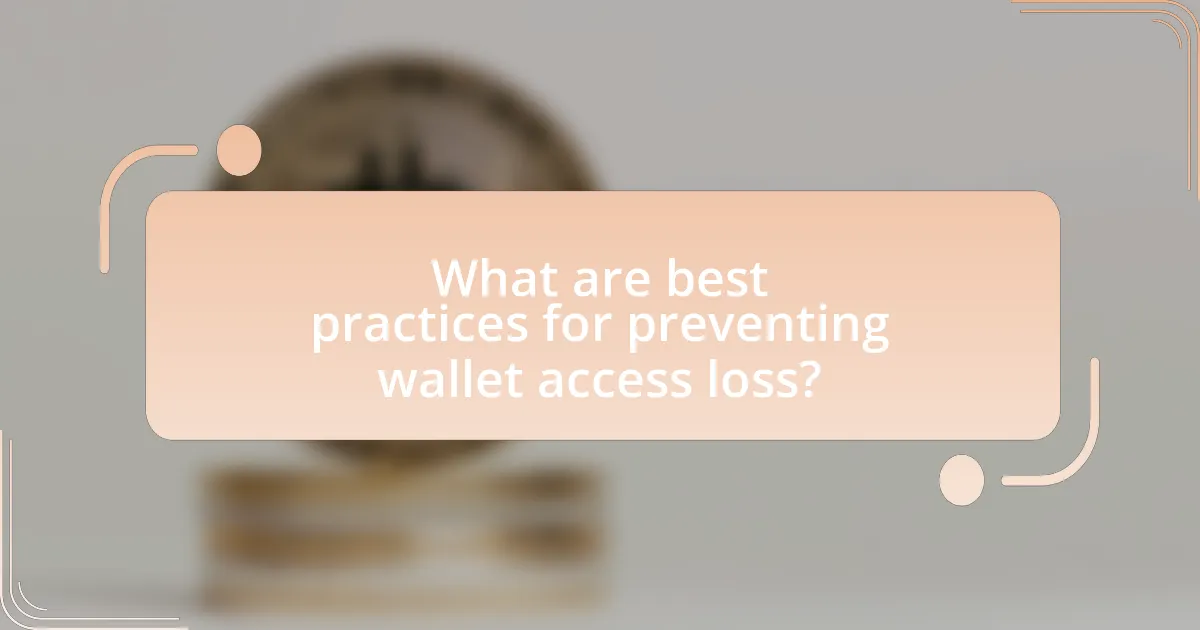Wallet recovery options are essential methods for regaining access to digital wallets after losing credentials or access. This article outlines the importance of having recovery options, the risks associated with losing access to a wallet, and how recovery methods can mitigate these risks. It discusses various types of wallets, including hot and cold wallets, and the differences in recovery options available for each. Additionally, the article provides practical steps for recovering access, tools and resources for wallet recovery, best practices for preventing access loss, and common mistakes to avoid. Understanding these aspects is crucial for safeguarding digital assets and ensuring their recoverability.

What are Wallet Recovery Options?
Wallet recovery options refer to the methods available for regaining access to a digital wallet after losing credentials or access. These options typically include using recovery phrases, backup keys, or contacting customer support for assistance. For instance, many cryptocurrency wallets provide a 12 to 24-word recovery phrase during setup, which can be used to restore access if the wallet is lost or the device is damaged. Additionally, some wallets allow users to set up multi-signature accounts, which require multiple keys for access, enhancing security and recovery options.
Why is it important to have recovery options for wallets?
Having recovery options for wallets is crucial because they provide a means to regain access to funds in case of loss or theft of access credentials. Wallets, particularly in the context of cryptocurrencies, often contain significant financial assets, and without recovery options, users risk permanent loss of their investments. For instance, a study by Chainalysis in 2021 indicated that over 20% of Bitcoin is considered lost due to lack of recovery methods. This highlights the necessity of implementing secure recovery options to safeguard against unforeseen circumstances that could lead to loss of access.
What risks are associated with losing access to a wallet?
Losing access to a wallet poses significant risks, primarily the permanent loss of funds stored within it. When an individual cannot access their wallet, they cannot retrieve cryptocurrencies or digital assets, leading to financial loss that is often irreversible. According to a study by Chainalysis, approximately 20% of all Bitcoin is considered lost due to inaccessible wallets, highlighting the severity of this risk. Additionally, losing access can result in the inability to participate in transactions or utilize services that require wallet verification, further compounding the financial implications.
How can recovery options mitigate these risks?
Recovery options can mitigate risks associated with losing access to a wallet by providing alternative methods to regain control over assets. These options, such as seed phrases, backup keys, and multi-signature setups, ensure that users can recover their wallets even if they forget passwords or lose devices. For instance, using a seed phrase allows users to restore their wallets on a new device, effectively safeguarding against loss. Additionally, multi-signature wallets require multiple keys for access, reducing the risk of unauthorized access and enhancing security. These methods have been proven effective, as evidenced by user testimonials and case studies demonstrating successful recoveries in various scenarios.
What types of wallets require recovery options?
Hot wallets and hardware wallets require recovery options. Hot wallets, which are connected to the internet, can be vulnerable to hacks, making recovery options essential for restoring access to funds. Hardware wallets, while more secure, also necessitate recovery options due to the risk of loss or damage to the physical device. Both types typically use seed phrases or backup keys to facilitate recovery, ensuring users can regain access to their assets in case of unforeseen circumstances.
What are the differences between hot wallets and cold wallets?
Hot wallets are online wallets that are connected to the internet, allowing for quick and easy access to cryptocurrencies, while cold wallets are offline storage solutions that provide enhanced security by keeping private keys disconnected from the internet. Hot wallets facilitate immediate transactions and are often used for daily trading, but they are more vulnerable to hacking and cyber threats. In contrast, cold wallets, such as hardware wallets or paper wallets, are less convenient for frequent transactions but significantly reduce the risk of unauthorized access, making them ideal for long-term storage of digital assets. The distinction between these two types of wallets is crucial for users to understand their security and accessibility trade-offs.
How do recovery options vary between different wallet types?
Recovery options vary significantly between different wallet types, primarily categorized into software wallets, hardware wallets, and paper wallets. Software wallets often provide recovery phrases or seed phrases that allow users to restore their wallets on different devices. Hardware wallets, on the other hand, typically require a recovery seed as well, but they also offer additional security features, such as the ability to recover funds through a secure device interface. Paper wallets, being physical representations of private keys, necessitate the secure storage of the printed keys and do not have built-in recovery options; losing the paper means losing access to the funds. Each wallet type’s recovery method reflects its design and intended use, emphasizing the importance of securely managing recovery information to prevent loss of access.

How can you recover access to your wallet?
To recover access to your wallet, you should utilize the recovery phrase or seed phrase that was provided during the wallet setup. This phrase typically consists of 12 to 24 words and is essential for restoring access to your wallet on a compatible platform. If you have lost your recovery phrase, recovery options may be limited, as many wallets do not have a way to reset access without it. Therefore, safeguarding your recovery phrase is crucial, as it serves as the primary method for regaining access to your wallet.
What steps should you take immediately after losing access?
Immediately after losing access to a wallet, the first step is to attempt to recover access using any available recovery phrases or backup keys. Recovery phrases, often consisting of a series of words, are crucial for regaining access to wallets, as they are designed to restore accounts. If the recovery phrase is not available, the next step is to check for any linked email accounts or phone numbers that may allow for account recovery through password reset options. Additionally, contacting customer support for the wallet service can provide guidance on recovery procedures specific to that platform. These steps are essential because they leverage the built-in recovery mechanisms that many wallet services offer, which are designed to assist users in regaining access to their accounts.
How can you use backup phrases or seed phrases for recovery?
Backup phrases or seed phrases can be used for recovery by entering them into a compatible wallet application to restore access to your cryptocurrency assets. These phrases, typically consisting of 12 to 24 words, serve as a master key that allows users to regenerate their private keys and regain control over their funds. When a user loses access to their wallet, whether due to device loss or software failure, inputting the correct seed phrase into a new or existing wallet application will restore the wallet’s contents, as the phrase is linked to the wallet’s cryptographic keys. This method is widely recognized in the cryptocurrency community as a secure and effective recovery option, ensuring that users can retrieve their assets as long as they keep their seed phrases safe and confidential.
What role do private keys play in wallet recovery?
Private keys are essential for wallet recovery as they provide the means to access and control the cryptocurrency stored within a wallet. When a user loses access to their wallet, having the private key allows them to restore their wallet on a different device or software, ensuring they can regain control over their assets. Without the private key, recovery is impossible, as it serves as the unique identifier that proves ownership of the funds. This critical role underscores the importance of securely storing private keys, as losing them equates to losing access to the associated cryptocurrency permanently.
What tools and resources are available for wallet recovery?
Wallet recovery tools and resources include recovery phrases, hardware wallets, software wallets, and professional recovery services. Recovery phrases, often consisting of 12 to 24 words, allow users to restore access to their wallets if lost. Hardware wallets, such as Ledger and Trezor, provide secure backup options and recovery processes. Software wallets, like Exodus and Electrum, also offer built-in recovery features. Additionally, professional recovery services can assist users in retrieving lost access, although they may charge fees. These resources are essential for ensuring that users can regain access to their digital assets in case of loss.
How can recovery software assist in regaining access?
Recovery software can assist in regaining access by scanning and retrieving lost or deleted wallet data from storage devices. This software employs algorithms that can identify and reconstruct wallet files, even if they have been partially overwritten or corrupted. For instance, many recovery tools utilize file signature recognition to locate specific wallet formats, enabling users to restore access to their cryptocurrency wallets effectively.
What online services can help with wallet recovery?
Online services that can assist with wallet recovery include recovery services like Wallet Recovery Services, which specializes in retrieving lost cryptocurrency wallets by utilizing advanced techniques to recover private keys. Additionally, platforms such as Crypto Recovery offer similar services, focusing on various types of wallets, including hardware and software options. These services often require users to provide specific information about their wallets and may charge a fee based on the complexity of the recovery process.

What are best practices for preventing wallet access loss?
To prevent wallet access loss, users should implement multiple security measures, including using hardware wallets, enabling two-factor authentication (2FA), and securely backing up recovery phrases. Hardware wallets provide offline storage, significantly reducing the risk of hacking. Two-factor authentication adds an extra layer of security by requiring a second form of verification, making unauthorized access more difficult. Additionally, securely backing up recovery phrases ensures that users can restore access to their wallets in case of device loss or failure. According to a study by the Blockchain Research Institute, 20% of cryptocurrency users have lost access to their wallets due to inadequate security practices, highlighting the importance of these preventive measures.
How can you securely store your recovery information?
To securely store your recovery information, utilize a combination of encrypted digital storage and physical backups. Encrypted digital storage, such as a password manager, ensures that your recovery phrases or keys are protected by strong encryption algorithms, making unauthorized access extremely difficult. For physical backups, write down your recovery information and store it in a safe location, such as a safe deposit box or a fireproof safe at home, to prevent loss due to hardware failure or cyber threats. This dual approach minimizes the risk of losing access to your wallet while ensuring that your recovery information remains confidential and secure.
What methods are effective for backing up wallet data?
Effective methods for backing up wallet data include using hardware wallets, software wallets with encrypted backups, and cloud storage solutions. Hardware wallets, such as Ledger or Trezor, provide a secure offline environment for storing private keys, making them less vulnerable to hacking. Software wallets often allow users to create encrypted backups of their wallet files, ensuring that even if the device is lost, the data can be restored. Additionally, cloud storage solutions, like Google Drive or Dropbox, can be utilized to store encrypted wallet backups, providing easy access across devices while maintaining security. These methods are widely recognized for their effectiveness in safeguarding wallet data against loss or theft.
How often should you update your recovery methods?
You should update your recovery methods regularly, ideally every six months or whenever there is a significant change in your personal circumstances or technology. Regular updates ensure that your recovery options remain relevant and effective, especially as security measures evolve and personal situations change. For instance, a study by the National Institute of Standards and Technology emphasizes the importance of regularly reviewing and updating security practices to mitigate risks associated with data loss or unauthorized access.
What common mistakes should you avoid regarding wallet recovery?
Common mistakes to avoid regarding wallet recovery include failing to back up recovery phrases securely, sharing recovery information with untrusted sources, and neglecting to update security measures after a recovery attempt. Failing to back up recovery phrases can lead to permanent loss of access, as these phrases are often the only way to regain control of a wallet. Sharing recovery information can expose users to phishing attacks, where malicious actors may attempt to steal funds. Additionally, neglecting to update security measures, such as enabling two-factor authentication, can leave wallets vulnerable to future breaches. These mistakes can significantly compromise the security and accessibility of digital assets.
How can sharing recovery information lead to security risks?
Sharing recovery information can lead to security risks by exposing sensitive data that can be exploited by malicious actors. When individuals share recovery phrases or private keys, they increase the likelihood of unauthorized access to their wallets. For instance, a study by the Blockchain Security Alliance found that 70% of cryptocurrency thefts were linked to compromised recovery information. This highlights the critical need for individuals to keep such information confidential to prevent potential financial loss and identity theft.
What are the consequences of neglecting wallet backups?
Neglecting wallet backups can lead to irreversible loss of access to digital assets. When users fail to create backups, they risk losing their private keys, which are essential for accessing cryptocurrencies or digital tokens stored in the wallet. Without these keys, recovery options become extremely limited, often resulting in the permanent loss of funds. According to a study by Chainalysis, approximately 20% of all Bitcoin is considered lost due to users not backing up their wallets or losing access to their private keys. This statistic underscores the critical importance of regular wallet backups to ensure the security and recoverability of digital assets.
What practical tips can help ensure wallet access is maintained?
To ensure wallet access is maintained, users should securely back up their recovery phrases and private keys. This practice is essential because losing these credentials can result in permanent loss of access to the wallet. Users should store backups in multiple secure locations, such as encrypted USB drives or secure cloud storage, to mitigate risks associated with physical damage or theft. Additionally, enabling two-factor authentication (2FA) adds an extra layer of security, making unauthorized access more difficult. Regularly updating software and using reputable wallet applications further enhances security, as these measures protect against vulnerabilities and exploits.